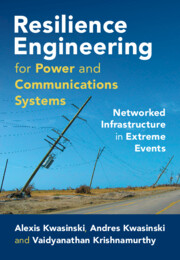 Resilience Engineering for Power and Communications Systems
Resilience Engineering for Power and Communications Systems Book contents
- Resilience Engineering for Power and Communications Systems
- Resilience Engineering for Power and Communications Systems
- Copyright page
- Contents
- Preface
- Acknowledgments
- 1 Introduction
- 2 Fundamental Supporting Concepts
- 3 Resilience Models and Metrics
- 4 Dependencies and Interdependencies and Their Effect on Resilience
- 5 Disaster Forensics of Infrastructure Systems
- 6 Electric Power Grid Resilience
- 7 Resilience of Information and Communication Networks
- 8 Integrated Electric Power and Communications Infrastructure Resilience
- 9 Infrastructure Systems Planning for Improved Resilience
- Index
- References
4 - Dependencies and Interdependencies and Their Effect on Resilience
Published online by Cambridge University Press: 04 January 2024
- Resilience Engineering for Power and Communications Systems
- Resilience Engineering for Power and Communications Systems
- Copyright page
- Contents
- Preface
- Acknowledgments
- 1 Introduction
- 2 Fundamental Supporting Concepts
- 3 Resilience Models and Metrics
- 4 Dependencies and Interdependencies and Their Effect on Resilience
- 5 Disaster Forensics of Infrastructure Systems
- 6 Electric Power Grid Resilience
- 7 Resilience of Information and Communication Networks
- 8 Integrated Electric Power and Communications Infrastructure Resilience
- 9 Infrastructure Systems Planning for Improved Resilience
- Index
- References
Summary
This chapter initially explains how dependencies are established when at least a part of an infrastructure system requires the provision of the service to function. Although the focus is on functional dependencies, this chapter also explores physical and conditional dependencies. Resilience metrics presented in previous chapters are broadened in order to represent the effect of dependencies on resilience levels. Dependencies established within an infrastructure system are also explained. The concept of buffer as a local storage of the resources related to the depending service is defined as part of these expanded metrics, and then it is exemplified by examining a practical application of such buffers: power plants for information and communication network (ICN) sites. After introducing the main concepts and ideas related to dependencies, this chapter takes a broader view by discussing interdependencies when those are established both directly and indirectly. The study of interdependencies for electric power grids and ICN also explores the relationship with other infrastructures, such as transportation networks and water distribution systems, and with community social systems.
- Type
- Chapter
- Information
- Resilience Engineering for Power and Communications SystemsNetworked Infrastructure in Extreme Events, pp. 161 - 194Publisher: Cambridge University PressPrint publication year: 2024


